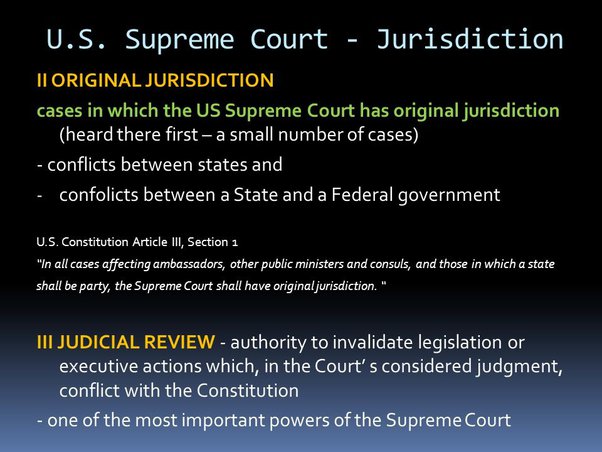Which case would the Supreme Court hear through its original jurisdiction power?
The United States Supreme Court holds a unique position in the federal judiciary, in part because of its original jurisdiction over certain types of cases. This means that the Supreme Court serves as the court of first impression for these cases, as opposed to hearing appeals from lower courts. Understanding which cases fall under the Supreme Court’s original jurisdiction provides insight into the Court’s constitutional role.
What is original jurisdiction?
In the federal court system, original jurisdiction refers to a court’s power to hear a case for the first time. This contrasts with appellate jurisdiction, through which higher courts like the Supreme Court hear appeals from trial court decisions.
Original jurisdiction derives directly from the Constitution or federal statutes. For the Supreme Court, original jurisdiction comes from Article III, Section 2 of the Constitution. Meanwhile, Congress holds authority to regulate the scope of original jurisdiction through legislative acts.
Constitutional sources of Supreme Court original jurisdiction
Article III of the Constitution delineates two major categories of original jurisdiction cases for the Supreme Court:
Disputes between states
The Supreme Court has exclusive jurisdiction over lawsuits between U.S. states. The framers believed federal resolution was appropriate for conflicts between states.
Cases involving ambassadors
The Court also possesses original jurisdiction over cases involving ambassadors and other public ministers. This supported the framers’ vision of national power over foreign affairs.
Beyond the Constitution, federal statutes occasionally grant original jurisdiction to the Supreme Court over other matters. However, the Court spends the vast majority of its time exercising appellate jurisdiction.
Key examples of original jurisdiction cases
Historical Examples
To gain a deeper understanding of the types of cases the Supreme Court has heard through its original jurisdiction over the years, let’s explore a few historical examples:
State vs. state disputes
The Supreme Court has adjudicated numerous border disputes between states. For example, New Jersey v. New York (1998) involved contested sovereignty over Ellis Island. More recently, the Court took up Alaska v. United States (2014) resolving discrepancies in the boundaries of the Alaska National Petroleum Reserve.
Cases involving ambassadors
Instances of original jurisdiction over ambassador-related cases are infrequent. Notably, in United States v. Ortega (1825), the Court held jurisdiction over the prosecution of a Spanish ambassador for crimes committed in the U.S.
Cases involving U.S. government
Beyond constitutional specifications, Congress authorized the Court’s original jurisdiction over cases involving the U.S. government. The seminal case was United States v. Texas (1892), which settled a dispute over territory between the federal government and Texas.
State Boundary Disputes
One prominent example involves the dispute between the states of Georgia and Tennessee over their boundary. The Supreme Court intervened in the early 19th century, ultimately settling the matter and solidifying the boundaries between the two states.
Disputes over Water Rights
In cases like Texas v. New Mexico, the Supreme Court exercised its original jurisdiction to address conflicts over water rights in the Rio Grande River. These cases are essential in ensuring fair allocation of vital resources among states.
Suits Against Federal Officials
The Supreme Court has also been called upon to hear cases against high-ranking federal officials. For instance, in Ex parte McCardle, the Court reviewed the case of a newspaper editor who was detained by a military official during the Reconstruction era. Such cases emphasize the importance of ensuring the government’s actions align with constitutional principles.
Limits on Supreme Court original jurisdiction
Despite the constitutional and statutory grants, the Supreme Court exercises discretion when accepting original jurisdiction cases.
Congressional control over jurisdiction
While Congress cannot expand the constitutional parameters of original jurisdiction, it can restrict them. For instance, Congress eliminated Supreme Court original jurisdiction over cases between a state and citizens of another state.
Court discretion in taking cases
The Supreme Court tends to avoid exercising the full extent of its original jurisdiction. The Court has indicated this jurisdiction should be “sparingly exercised.” As the ultimate appellate body, the Supreme Court prefers to allow cases to proceed through lower courts first.
Conclusion
In summary, the Supreme Court’s original jurisdiction derives from Article III of the Constitution and federal statutes. This grants the Court first impression authority over cases involving states, ambassadors, and sometimes the U.S. government. However, original jurisdiction makes up a very small portion of the modern Supreme Court’s docket. Understanding the distinction from appellate jurisdiction provides insight into the judiciary’s structure.
FAQs
What are the main types of original jurisdiction cases?
The Constitution grants the Supreme Court original jurisdiction over cases between U.S. states and cases involving ambassadors or public ministers. Some federal laws also authorize original jurisdiction over cases involving the U.S. government.
How often does the Supreme Court exercise original jurisdiction?
Very rarely. The vast majority of the Supreme Court’s cases involve appellate jurisdiction over appeals from lower courts. They invoke original jurisdiction sparingly.
Are there limits on the Supreme Court’s original jurisdiction?
Yes. While Congress cannot expand original jurisdiction beyond constitutional specifications, it can restrict it. The Court also exercises discretion in accepting original jurisdiction cases.
Why does the Supreme Court have original jurisdiction?
The framers wanted the Supreme Court to have first impression authority over sensitive cases between states and those involving foreign diplomacy. This supported their national sovereignty goals.
What is the difference between original and appellate jurisdiction?
Courts exercise original jurisdiction when hearing a case for the first time. Appellate jurisdiction involves reviewing lower court decisions on appeal and is more common for the Supreme Court








